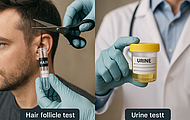What to Do After Failing a DOT Physical in Columbia

Failing a DOT physical means you can’t drive. The job stops. The pay stops. You need answers and a plan, not panic. The next move decides how fast you get back behind the wheel.

Why Drivers Lose Their Medical Cards
DOT medical cards don’t get pulled for minor issues. The most common reasons are clear and specific:
- Blood pressure that stays above the DOT limit, even after a second check
- Vision that falls short of the minimum standard, even with corrective lenses
- Hearing loss that blocks safe communication on the road
- Sleep apnea that isn’t managed or diagnosed
- Diabetes that’s out of control or not monitored
- Heart problems that need more testing or specialist clearance
- Medications that slow reaction time or cause drowsiness
These aren’t just numbers on a chart. High blood pressure can trigger headaches, blurred vision, and fatigue. Poor vision or hearing means missed signals and slower response. Sleep apnea leaves drivers exhausted, even after a full night’s rest. Unmanaged diabetes brings unpredictable blood sugar swings. Shaky hands, confusion, and risk behind the wheel. Heart conditions can cause chest pain or shortness of breath. Medications that affect alertness make long hauls dangerous. Each issue blocks safe driving, and the DOT examiner won’t ignore them. For a deeper look at the health issues that can impact your card, see what health issues affect your DOT medical card.
What to Do Right After Failing
Shock and frustration hit hard, but the first move is simple: get the facts. The examiner must give a written summary of every failed item. Don’t leave the office without it. This document spells out exactly what needs fixing. No guessing, no rumors, just the truth.
Next, talk to your employer. Don’t wait for them to call you. Most companies have a process for drivers who lose their medical card. Some offer light duty or temporary assignments. Others require time off until you’re cleared. Either way, your boss needs to know your status and your plan. This protects your job and keeps you in the loop.
Legal questions come up fast. Can you keep working? What happens to your CDL? The answers depend on your company, your state, and the reason for failure. For a breakdown of what’s at stake, review of failing a DOT physical legal implications of failing a DOT physical.
Finally, start a file. Keep every document, test result, and note from your doctor. This paperwork will be essential when you’re ready to retest.
Fixing the Problem
Getting back on the road takes more than a quick retest. The real work happens between exams. Start with your primary care provider or a specialist. Bring the examiner’s report and ask for a clear plan. For high blood pressure, this might mean new medication, diet changes, or daily monitoring. For vision or hearing, schedule an appointment with an optometrist or audiologist. Sleep apnea often requires a sleep study and a CPAP machine. Diabetes needs tighter control. Regular blood sugar checks, medication adjustments, and a log of your readings. Heart issues may call for a cardiologist’s clearance and extra tests.
Stick to the plan. Take medications as prescribed. Track your progress. Bring every new result to your next appointment. Many drivers return to work after a few weeks or months of focused effort. For practical tips on staying healthy between exams, check out proper health maintenance strategies between DOT physicals.
- Follow every doctor’s order, no shortcuts
- Keep a daily log of blood pressure, blood sugar, or sleep hours if required
- Bring proof of compliance to your retest
- Ask for a letter from your provider if you’ve completed treatment or stabilized a condition
Understanding Your Timeline
Not every failure leads to the same wait. Some issues, like a missed vision standard, can be fixed and retested in days. Others, such as uncontrolled diabetes or a new heart diagnosis, require weeks or months of documentation. The examiner decides when you’re eligible for a retest, but specialist clearance often speeds things up. Don’t guess. Ask for a clear timeline at every step. For a list of the most common reasons drivers fail and how long each takes to resolve, see common DOT physical failures.
- Vision or hearing correction: retest as soon as you have new glasses or hearing aids
- Blood pressure: retest after a week or two of stable readings
- Sleep apnea: retest after using a CPAP and showing compliance data
- Diabetes: retest after your provider confirms stable control
- Heart conditions: retest after specialist clearance and any required tests
Keep your employer updated. Share your expected return date and any changes. This keeps your job secure and shows you’re serious about getting back to work.
Getting Ready for Your Retest
Preparation makes the difference. Bring every document, prescription, and compliance log to your retest. Arrive early, rested, and ready. Don’t skip meals or medication. If you’ve made changes, such as new glasses, new medication, or new equipment, bring proof. The examiner needs to see results, not promises.
- Pack your medication bottles and logs
- Bring letters from doctors or specialists
- Show CPAP compliance data if you have sleep apnea
- Have your new glasses or hearing aids on hand
Every detail counts. The examiner wants proof that you’re safe to drive. Give them everything they need the first time.
Schedule Your DOT Physical Retest in Columbia
Ready to get back on the road? At Midlands Exams & Drug Screening, Inc, we provide thorough DOT physicals with clear guidance on meeting requirements. Our team understands the urgency and works to make your retest process as smooth as possible. Call 803-790-2045 or contact us to schedule your retest today.
‹ Back
.png)
.png)





.png)
